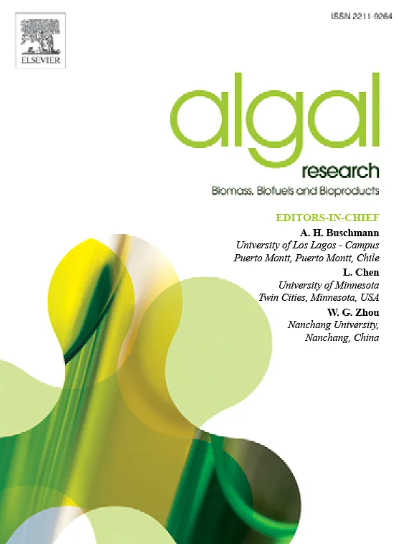Whether controlling hydrodynamic conditions is an effective solution to alleviate cyanobacterial blooms
IF 4.6
2区 生物学
Q1 BIOTECHNOLOGY & APPLIED MICROBIOLOGY
Algal Research-Biomass Biofuels and Bioproducts
Pub Date : 2025-05-08
DOI:10.1016/j.algal.2025.104083
引用次数: 0
Abstract
The main purpose of this study was to determine the threshold and mechanism of the fluid field affecting cyanobacterial blooms based on monitoring of Taihu Lake fluid field data combined with artificial simulation experiments. The increase of carbon dioxide (CO2) content in L-wave (wind speed of 3 m s−1, wave height of 0.03 m) under simulated low wind waves promoted the peak of cell density, chlorophyll-a and optimal/maximal quantum yield of PSII (Fv/fm). At the same time, the water flow of 0.004–0.008 m s−1 increased the collision frequency between cyanobacteria cells and activated the activity of antioxidant enzymes, so that cyanobacteria in the L-wave secreted more extracellular polymers (EPS) and α-d-glucopyranose, thereby enhancing cell adhesion. The maximum cell size of cyanobacteria was observed under the condition of L-wave strongly indicated that the low wind and wave environment promoted the formation of cyanobacterial blooms. However, the fluid field intensity was further enhanced to simulate the high-wave (H-wave, i.e., wind speed 3 m s−1 and wave height 0.1 m). The excessive shear stress (4.54 × 10−2 Pa) under H-wave produced a large amount of reactive oxygen species (ROS), which caused oxidative stress damage to cyanobacteria. The expression of peroxiredoxin (prx) increased by 1.57 times, which fully confirmed the imbalance of ROS scavenging system in cyanobacteria cells in H-wave, thereby inhibiting the formation of cyanobacterial blooms. By combining the monitoring and simulation experiments of Taihu Lake and using the structural equation model, it was found that adjusting the intensity of fluid field, colony formation and biomass were effective strategies to alleviate the outbreak of cyanobacterial blooms.
Novelty and relevance statement
The optimal fluid field thresholds and mechanism for bloom formation were determined through a combination of field monitoring and artificial simulation. However, exceeding this threshold (wind speed 3 m s−1 and wave height 0.03 m) inhibited the formation of cyanobacterial blooms. This study will provide new insights and guidance for bloom control.

控制水动力条件是否是缓解蓝藻华的有效解决方案
本研究的主要目的是在太湖流体场监测数据的基础上,结合人工模拟实验,确定流体场对蓝藻华的影响阈值及其作用机制。模拟低风浪条件下l波(风速3 m s−1,波高0.03 m) CO2含量的增加促进了PSII细胞密度、叶绿素a和最佳/最大量子产率(Fv/fm)的峰值。同时,0.004-0.008 m s−1的水流量增加了蓝藻细胞之间的碰撞频率,激活了抗氧化酶的活性,使l波中的蓝藻分泌更多的胞外聚合物(EPS)和α-d-葡萄糖吡喃糖,从而增强了细胞粘附性。l波条件下蓝藻细胞大小最大,表明低风浪环境促进了蓝藻华的形成。进一步增强流场强度,模拟高波(h波,即风速3 m s−1,波高0.1 m)。h波下的过度剪切应力(4.54 × 10−2 Pa)产生大量活性氧(ROS),对蓝藻造成氧化应激损伤。过氧化氧还蛋白(peroxredoxin, prx)的表达增加了1.57倍,充分证实了h波下蓝藻细胞中ROS清除系统的失衡,从而抑制了蓝藻华的形成。结合太湖监测与模拟实验,运用结构方程模型,发现调节流场强度、菌落形成和生物量是缓解蓝藻华爆发的有效策略。新颖性和相关性陈述通过现场监测和人工模拟相结合,确定了最佳流体场阈值和水华形成机制。然而,超过这个阈值(风速3 ms - 1,浪高0.03 m)会抑制蓝藻华的形成。本研究将为花华防治提供新的见解和指导。
本文章由计算机程序翻译,如有差异,请以英文原文为准。
求助全文
约1分钟内获得全文
求助全文
来源期刊

Algal Research-Biomass Biofuels and Bioproducts
BIOTECHNOLOGY & APPLIED MICROBIOLOGY-
CiteScore
9.40
自引率
7.80%
发文量
332
期刊介绍:
Algal Research is an international phycology journal covering all areas of emerging technologies in algae biology, biomass production, cultivation, harvesting, extraction, bioproducts, biorefinery, engineering, and econometrics. Algae is defined to include cyanobacteria, microalgae, and protists and symbionts of interest in biotechnology. The journal publishes original research and reviews for the following scope: algal biology, including but not exclusive to: phylogeny, biodiversity, molecular traits, metabolic regulation, and genetic engineering, algal cultivation, e.g. phototrophic systems, heterotrophic systems, and mixotrophic systems, algal harvesting and extraction systems, biotechnology to convert algal biomass and components into biofuels and bioproducts, e.g., nutraceuticals, pharmaceuticals, animal feed, plastics, etc. algal products and their economic assessment
 求助内容:
求助内容: 应助结果提醒方式:
应助结果提醒方式:


